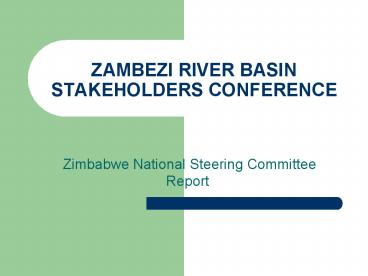ZAMBEZI RIVER BASIN STAKEHOLDERS CONFERENCE - PowerPoint PPT Presentation
1 / 30
Title:
ZAMBEZI RIVER BASIN STAKEHOLDERS CONFERENCE
Description:
Institutional reforms dates back to the 70s ... 2000 WRMS NSC was Disbanded (debate NSC) 2002 Association of Catchment Councils Launched ... – PowerPoint PPT presentation
Number of Views:89
Avg rating:3.0/5.0
Title: ZAMBEZI RIVER BASIN STAKEHOLDERS CONFERENCE
1
ZAMBEZI RIVER BASIN STAKEHOLDERS CONFERENCE
- Zimbabwe National Steering Committee Report
2
CONTENTS
- BACKGROUND
- INTRODUCTION
- OBJECTIVES OF THE NSC
- MEMBERSHIP OF THE NSC
- NSC ACTIVITIES
- CONCLUSION
3
BACKGROUND
- Institutional reforms dates back to the 70s
- The Water Act of 1976 introduced Water
Development Advisory Council (WDACs) based on
Catchments - Water Act revision of 1984 introduce Riverboards
- 1994 a National Steering Committee introduced to
develop a WRMS
4
BRIEF HISTORY (cont.)
- Water Act Revision of 1998 Introduced
- Catchment and Subcatchment Councils
- abolished WDAC and River-boards
- 2000 Catchment institutions operationalized
- 2000 WRMS NSC was Disbanded (debate NSC)
- 2002 Association of Catchment Councils Launched
- Sept 2002 ZACPRO NSC Launched
5
INTRODUCTION
- NSC launched in September 2002
- Comprise of representatives of stakeholder
institutions - NSC initially for the Zambezi basin extended to
cover the whole country in May 2005. - Meets regularly (1 AGM)
- Zimbabwe has 7 catchments, 4 drain into the
Zambezi Basin - Gwayi, Sanyati, Manyame, Mazowe.
6
(No Transcript)
7
Current Institutional Set up
- Inter-linked and relate to each other
NSC
National Level
Catchment Councils (CC)
Catchment Level
Sub-Catchment Councils
Sub-Catchment
Stakeholder Associations
Scheme specific
8
OBJECTIVES OF THE NSC
- Overall objective
- to develop policies and inputs on water
management for national and international
watercourse ways and bearing in mind the Water
Resources Management Strategy (WRMS), Millenium
Goals, SADC Water Policy, the interests of
Zimbabwean Stakeholders, regional cooperation and
good neighbourliness, compliance with legal
international and national obligations,
environmental concerns, and sustainable
development of watercourses.
9
OBJECTIVES (Cont.)
- The objectives of the NSC as outlined in the
constitution are to- - Advise the Minister on policy issues at national
and international levels - Ensure co-ordination of effort by the various
institutions involved in the water sector - Facilitate the realisation of the objectives of
the ZACPRO 6 Phase II project and any other water
related projects.
10
OBJECTIVES (Cont.)
- Monitor and evaluate proposed and actual water
related developments within the river basins
beyond our borders. - Develop priorities and recommendations within
Zimbabwe of projects related to water
development. - Consult with and report back to the Zimbabwean
Stakeholders. - Facilitate public awareness regarding
developments in Zimbabwe watercourses.
11
OBJECTIVES (Cont.)
- Facilitate the identification of national
capacity requirements and training needs in
integrated water resources management and
facilitate capacity building. - Play a significant role in the development of
long term strategy for Zimbabwe for water
development in Zimbabwe Watercourses. - Ensure the long-term sustainability of the NSC in
terms of legal and administrative obligations.
12
OBJECTIVES (Cont.)
- Ensure that gender issues are given due
consideration in all deliberations - Ensure that environmental issues are given due
consideration
13
MEMBERSHIP OF THE NSC
- General Membership
- Water Sector
- Agricultural Sector
- Energy Sector
- Environmental Sector
- Local Authorities Sector
- Mining Sector
- Health Sector
- Interest Groups (NGOs, Universities etc.)
14
COMMITTEE OF THE NSC
- Consists of 20 members as follows
- 4 Government Ministries
- Water, Environment, Local Government, Agriculture
- 7 Catchment Councils
- 3 NGOs
- 6 Parastatals/Institutions
15
NSC EXECUTIVE COMMITTEE
- Six Member Executive Committee
- Chairperson
- Vice Chairperson
- 4 Members from the Stakeholders
16
ACTIVITIES OF NSC
- 11 Major IWRM Issues Raised
- Politics
17
ACTIVITIES OF NSC (Cont.)
- Catchment Planning
18
ACTIVITIES OF NSC (Cont.)
- Environment
19
ACTIVITIES OF NSC (Cont.)
- Coordination
20
ACTIVITIES OF NSC (Cont.)
- Water Permits
21
ACTIVITIES OF NSC (Cont.)
- Expertise
22
ACTIVITIES OF NSC (Cont.)
- Institutional Legal
23
ACTIVITIES OF NSC (Cont.)
- Project Implementation
24
ACTIVITIES OF NSC (Cont.)
- Water Resources Monitoring
25
ACTIVITIES OF NSC (Cont.)
- Awareness
26
ACTIVITIES OF NSC (Cont.)
- Gender
27
SEPTEMBER 2005 AGM ISSUES
- Awareness Creation
- Complete and Review Catchment Outline Plans
- Strengthen Catchment Councils
- Finalise Constitution
- Pollution Control
28
SEPTEMBER 2005 AGM ISSUES (Cont.)
- Maps (Land-use/Cover and Water Resources)
- Operationalisation of ZAMCOM
- Link with other NSCs
- Women Participation in NSC
- Advisory Role to Government
29
SEPTEMBER 2005 AGM ISSUES (Cont.)
- Mobilise Finances
- Inventory of IWRM Issues
- Mazowe Dam Study
- Permit Compliance
30
CONCLUSION
- Water Reform Challenges facing the Zimbabwe NSC
- Stakeholder participation - capacity
- Equitable sharing of Water Resources
- Efficient use of Water
- Environmental Sustainability































